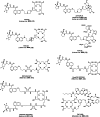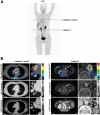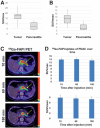Clinical applications of fibroblast activation protein inhibitor positron emission tomography (FAPI-PET)
- PMID: 40604259
- PMCID: PMC12118769
- DOI: 10.1038/s44303-024-00053-z
Clinical applications of fibroblast activation protein inhibitor positron emission tomography (FAPI-PET)
Abstract
The discovery of fibroblast activation protein inhibitor positron emission tomography (FAPI-PET) has paved the way for a new class of PET tracers that target the tumor microenvironment (TME) rather than the tumor itself. Although 18F-fluorodeoxyglucose (FDG) is the most common PET tracer used in clinical imaging of cancer, multiple studies have now shown that the family of FAP ligands commonly outperform FDG in detecting cancers, especially those known to have lower uptake on FDG-PET. Moreover, FAPI-PET will have applications in benign fibrotic or inflammatory conditions. Thus, even while new FAPI-PET tracers are in development and applications are yet to enter clinical guidelines, a significant body of literature has emerged on FAPI-PET, suggesting it will have important clinical roles. This article summarizes the current state of clinical FAPI-PET imaging as well as potential uses as a theranostic agent.
© 2024. The Author(s).
Conflict of interest statement
Competing interests: F.L.G. has a patent application for quinolone-based FAP-targeting agents for imaging and therapy in nuclear medicine and is a shareholder of a consultancy group for iTheranostics. F.L.G. is also an advisor at ABX, Telix, Alpha Fusion, and SOFIE Biosciences. U.H. receives royalties from iTheranostics and SOFIE Biosciences and possesses a patent for FAPI tracers licensed to SOFIE Biosciences. The other authors declare no conflict of interest regarding this manuscript.
Figures










Similar articles
-
Head-To-Head Comparison of 68Ga-FAPI PET/CT and FDG PET/CT for the Detection of Peritoneal Metastases: Systematic Review and Meta-Analysis.AJR Am J Roentgenol. 2023 Apr;220(4):490-498. doi: 10.2214/AJR.22.28402. Epub 2022 Nov 2. AJR Am J Roentgenol. 2023. PMID: 36321984
-
Comparison of Al 18 F-NOTA-FAPI-74 and 18 F-FDG PET/CT in the Evaluation and Staging of Hepatobiliary Malignancies : A Single-center Prospective Study.Clin Nucl Med. 2025 Jul 1;50(7):612-622. doi: 10.1097/RLU.0000000000005889. Epub 2025 Apr 24. Clin Nucl Med. 2025. PMID: 40279677
-
Fibroblast Activation Protein Inhibitor (FAPI)-Based Theranostics-Where We Are at and Where We Are Heading: A Systematic Review.Int J Mol Sci. 2023 Feb 15;24(4):3863. doi: 10.3390/ijms24043863. Int J Mol Sci. 2023. PMID: 36835275 Free PMC article.
-
Fibroblast Activation Protein Inhibitor (FAPI) PET in Sarcoma: An Update and Future Perspective.Semin Nucl Med. 2025 Sep;55(5):734-739. doi: 10.1053/j.semnuclmed.2025.05.003. Epub 2025 Jun 1. Semin Nucl Med. 2025. PMID: 40456674 Review.
-
FAPI-avid nonmalignant PET/CT findings: An expedited systematic review.Semin Nucl Med. 2023 Sep;53(5):694-705. doi: 10.1053/j.semnuclmed.2023.02.001. Epub 2023 Feb 20. Semin Nucl Med. 2023. PMID: 36813670
Cited by
-
FAP inhibitors: are we really using the best method to evaluate the residence time?Eur J Nucl Med Mol Imaging. 2025 Jul;52(9):3062-3065. doi: 10.1007/s00259-025-07160-y. Eur J Nucl Med Mol Imaging. 2025. PMID: 40000458 Free PMC article. No abstract available.
-
FAPI-Targeted Molecular Imaging: Transforming Insights into Post-Ischemic Myocardial Remodeling?Mol Diagn Ther. 2025 Jul;29(4):435-442. doi: 10.1007/s40291-025-00778-6. Epub 2025 Apr 22. Mol Diagn Ther. 2025. PMID: 40263181 Free PMC article. Review.
-
[18F]AlF-NOTA-FAPI-04 PET/CT improves detection of subcentimeter recurrent lesions in differentiated thyroid cancer.Eur J Nucl Med Mol Imaging. 2025 Jul 15. doi: 10.1007/s00259-025-07433-6. Online ahead of print. Eur J Nucl Med Mol Imaging. 2025. PMID: 40663160
-
Patent spotlight on theranostics targeting fibroblast activation protein for personalized cancer care.Pharm Pat Anal. 2024;13(4-6):149-160. doi: 10.1080/20468954.2025.2500811. Epub 2025 May 6. Pharm Pat Anal. 2024. PMID: 40328490 Free PMC article. Review.
References
-
- Dvorak, H. F. Tumors: wounds that do not heal. Similarities between tumor stroma generation and wound healing. N. Engl. J. Med.315, 1650–1659 (1986). - PubMed
-
- Goldstein, L. A. et al. Molecular cloning of seprase: a serine integral membrane protease from human melanoma. Biochim. Biophys. Acta1361, 11–19 (1997). - PubMed
Publication types
LinkOut - more resources
Full Text Sources
Miscellaneous
